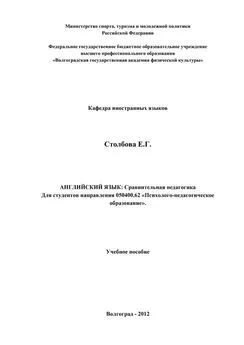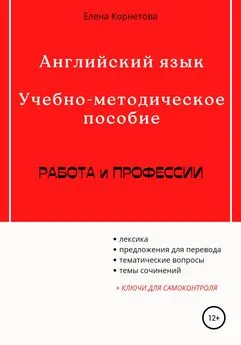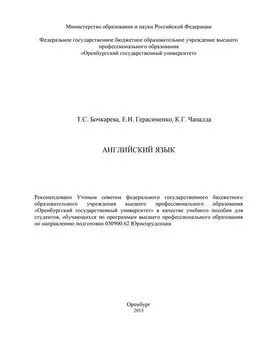Елена Беликова - Английский язык
- Название:Английский язык
- Автор:
- Жанр:
- Издательство:неизвестно
- Год:неизвестен
- ISBN:нет данных
- Рейтинг:
- Избранное:Добавить в избранное
-
Отзывы:
-
Ваша оценка:
Елена Беликова - Английский язык краткое содержание
Студенту без шпаргалки никуда! Удобное и красивое оформление, ответы на все экзаменационные вопросы ведущих вузов России.
Английский язык - читать онлайн бесплатно полную версию (весь текст целиком)
Интервал:
Закладка:
air – воздух
bloodstream – кровоток
airways – воздушные пути
alveoli – альвеолы
blood vessels – кровеносные сосуды
lungs – легкие
chest – грудь
diaphragm – диафрагма
the systemic blood vessels – системные кровеносные сосуды
red blood cells – красные кровяные клетки
plasma – плазма
respi ratory control neurons – дыхательные нейроны контроля
brainstem – ствол мозга
sensory – сенсорный
motor connections – моторные связи
ventilation – вентиляция
transport – транспортировка
environment exchange – окружающая среда
surface – поверхность
29. Lung volumes and capacities
Lung volumes – there are four lung volumes, which when added together, equal the maximal volume of the lungs. Tidal volume is the volume of one inspired or expected normal breath (average human = 0,5 L per breath). Inspiratory reserve volume is the volume of air that can be inspired in excess of the tidal volume. Expiratory reserve volume is the extra an that can be expired after a normal tidal expiration.
Residual volume is the volume of gas that re lungs after maximal expiration (average human = 1,2 L).
Total lung capacity is the volume of gas that can be con tained within the maximally inflated lungs (average human = 6 L).
Vital capacity is the maximal volume that can be expelled after maximal inspiration (average human = 4,8 L).
Functional residual capacity is the volume remaining in the lungs at the end of a normal tidal expiration (average luman = 2,2 L).
Inspiratory capacity is the volume that can be taken into the lungs after maximal inspiration following expiration of a normal breath. Helium dilution techniques are used to determine residual volume, FRC and TLC. A forced vital capacity is obtained when a subject inspires maximally and then exhales as forcefully and as completely as possible. The forced expiratory volume (FEV1) is the volume of air exhaled in the first second. Typically, the FEV1 is approximate 80 % of the FVC.
GAS LAWS AS APPLIED TO RESPIRATORY PHYSIOLOGY: Dalton's Law: In a gas mixture, the pressure exerted by each gas is independent of the pressure exerted by the other gases.
A consequence of this is as follows: partial pressure = total pressure x fractional concentration. This equation can be used to determine the partial pressure of oxygen in the atmosphere. Assuming that the total pressure (or barometric pressure, PB) is atmospheric pressure at sea level (760 mmHg) and the fractional concentration of O 2is 21 %, or 0,21: P02 = 760 mmHg Ч 0,21 = 160 mmHg. As air moves into the airways, the partial pressures of the va-ri ous gases in atmospheric air are reduced because of the addi tion of water vapor (47 mmHg). Henry's Law states that the concentration of a gas dissolved in liquid is proportional to its partial pressure and its solubility coef fi-cient (Ks). Thus, for gas X, [X] = Ks Ч Px
Fick's Law states that the volume of gas that diffuses across a barrier per unit time is given by:
Vgas = Y x D x (P1 – P2)
where A and T are the area and thickness of the barrier, P1 and P2 are the partial pressures of the gas on either side of the barrier and D is the diffusion constant of the gas. D is directly proportional to the solubility of the gas and inversely proportional to the square root of its molecular weight.
lung – легкое
tidal – вдыхаемый и выдыхаемый
inspired – вдохновленный
breath – дыхание
human – человек
residual – oстаточный
helium – гелий
dilution – растворение
techniques – методы
the conducting – проведение
30. Ventilation
Total ventilation (VT, minute ventilation) is the total gas flow into the lungs per minute. It is equal to the tidal volume (VT) x the respiratory rate (n). Total ventilation is the sum of dead space ventilation and alveolar ventilation.
Anatomic dead space is equivalent to the volume of the conducting airways (150 mL in normal individuals), i. e., the trachea and bronchi up to and including the terminal bronchioles. Gas exchange does not occur here. Physiologic dead space is the volume of the respiratory tract that does not participate in gas exchange. It includes the anatomic dead space and partially functional or nonfunctional alveoli (e. g., because of a pulmonan embolus preventing blood supply to a region of alveoli). In normal individuals, anatomic and physiologic dead space are approximately equal. Physiologic dead space can greatly exceed anatomic dead space in individuals with lung disease.
Dead space ventilation is the gas flow into dead space per minute. Alveolar ventilation is the gas flow entering functional alveoli per minute.
Alveolar ventilation: It is the single most important parameter of lung function. It cannot be measured directly. It must be adequate for removal of the CO 2produced by tissue metabolism whereas the partial pressure of inspired O 2is 150 mmHg, the partial pressure of O 2in the alveoli is typically 100 mmHg because of the displacement of O 2with CO 2. PAo2 cannot be measured directly.
total – общее количество
ventilation – вентиляция
flow – поток
per minute – в минуту
equal – равный
airways – воздушные пути
exchange – обмен
tract – трактат
to be measured – быть измеренным
directly – непосредственно
displacement – смещение
Air moves from areas of higher pressure to areas of lower pres sure just as fluids do. A pressure gradient needs to be established to move air.
Alveolar pressure becomes less than atmospheric pressure when the muscles of inspiration enlarge the chest cavity, thus lowering the intrathoracic pressure. Intrapleural pressure decreases, causing expansion of the alveoli and reduction of intra-alveolar pressure. The pressure gradient between the atmosphere and the alveoli drives air into the airways. The opposite occurs with expiration.
Air travels in the conducting airways via bulk flow (mL/min). Bulk flow may be turbulent or laminar, depending on its velocity. Velocity represents the speed of movement of a single particle in the bulk flow. At high velocities, the flow may be turbulent. At lower velocities transitional flow is likely to occur. At still lower velocities, flow may be laminar (streamlined). Reynold's number predicts the air flow. The higher the number, the more likely the air will be turbulent. The velocity of particle movement slows as air moves deeper into the lungs because of the enormous increase in cross-sectional area due to branching. Diffusion is the primary mechanism by which gas moves between terminal bronchioles and alveoli (the respiratory zone).
Airway resistance: The pressure difference necessary to produce gas flow is directly related to the resistance caused by friction at the airway walls. Medium-sized airways (› 2 mm diameter) are the major site of airway resistance. Small airways have a high individual resistance. However, their total resistance is much less because resistances in parallel add as reciprocals.
Factors affecting airway resistance: Bronchocon-striction (increased resistance) can be caused by parasympathetic stimulation, histamine (immediate hyper-sensitivity reaction), slow-reacting substance of anaphylaxis (SRS-A = leukotrienes C4, D4, E4; mediator of asthma), and irritants. Bronchodilation (decreased resistance) can be caused by sympathetic stimulation (via beta-2 receptors). Lung volume also affects airway resistance. High lung volumes lower airway resistance because the surrounding lung parenchyma pulls airways open by radial traction. Low lung volumes lead to increased airway resistance because there is less traction on the airways. At very low lung volumes, bronchioles may collapse. The viscosity or density of inspired gases can affect airway resistance. The density of gas increases with deep sea diving, leading to increased resistance and work of breathing. Low-density gases like helium can lower airway resistance During a forced expiration, the airways are compressed by increased intrathoracic pressure. Regardless of how forceful the expiratory effort is, the flow rate plateaus and cannot be exceeded. Therefore, the air flow is effort-independent; the collapse of the airways is called dynamic compression. Whereas this phenomenon is seen only upon forced expiration in normal subjects, this limited flow can be seen during normal expiration in patients with lung diseases where there is increased resistance (e. g., asthma) or increased compliance (e. g., emphysema).
intrapleural – внутриплевральный
intra-alveolar – внутриальвеолярный
collapse – коллапс
viscosity – вязкость
density – плотность
32. Mechanics of breathing
Muscles of respiration: inspiration is always an active process. The following muscles are involved: The diaphragm is the most important muscle of inspiration. It is convex at rest, and flattens during contraction, thus elongating the thoracic cavity. Contraction of the external intercostals lifts the rib cage upward and outward, expanding the thoracic cavity. These muscles are more important for deep inhalations. Accessory muscles of inspiration, including the scalene (elevate the first two ribs) and sternocleidomastoid (elevate the sternum) muscles, are not active during quiet breathing, but become more important in exercise. Expiration is normally a passive process. The lung and chest wall are elastic and naturally return to their resting positions after being actively expanded during inspiration. Expiratory muscles are used during exercise, forced expiration and certain disease states. Abdominal muscles (rectus abdominis, internal and external obliques, and transversus abdominis) increase intra-abdominal pressure, which pushes the diaphragm up, forcing air out of the lungs. The internal intercostal muscles pull the ribs downward and inward, decreasing the thoracic volume. Elastic properties of the lungs: the lungs collapse if force is not applied to expand them. Elastin in the alveolar walls aids the passive deflation of the lungs. Collagen within the pulmonary interstitium resists further expansion at high lung volumes. Compliance is defined as the change in volume per unit change in pressure (AV/AP). In vivo, compliance is measured by esophageal balloon pres sure vs. lung volume at many points during inspiration and expiration. Each measurement is made after the pressure and volume have equilibrated and so this is called static compliance. The compliance is the slope of the pressure-volume curve. Several observations can be made from the pressure-volumecurve.
Note that the pressure-volume relationship is different with deflation than with inflation of air (hysteresis). The compliance of the lungs is greater (the lungs are more distensible) in the middle volume and pressure ranges.
The equation for oxygen is:
QO 2= CO х 1,34 (ml/g) х [Hg] Ч SaO 2+ 0,003 (ml/ml per mm Hg) х РаО 2,
where QO 2is oxygen delivery (ml/min), CO is cardiac output (L/min). Hg is hemoglobin concentration (g/L), SaO 2is the fraction of hemoglobin saturated with oxygen, and PaO 2is the partial pressure of the oxygen dissolved in plasma and is trivial compare to the amount of oxygen carried by hemoglobin. Examination of this equation reveals that increasing hemoglobin concentration and increasing cardiac output can enhance oxygen delivery. Saturation is normally greater than 92 % and usually is easily maintained through supplemental oxygen and mechanical ventilation. Cardiac output is supported be insuring adequate fluid resuscitation (cardiac preload) and manipulating contractility and after load pharmacologically (usually cat-echolamines).
Читать дальшеИнтервал:
Закладка:










